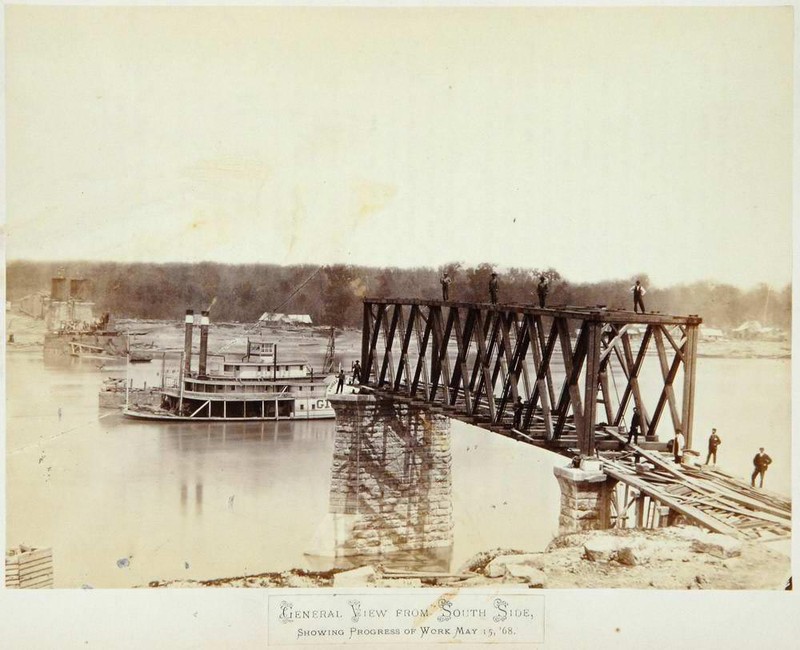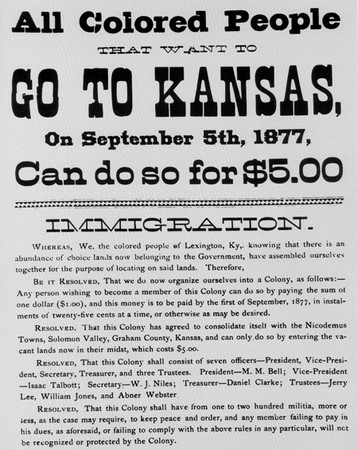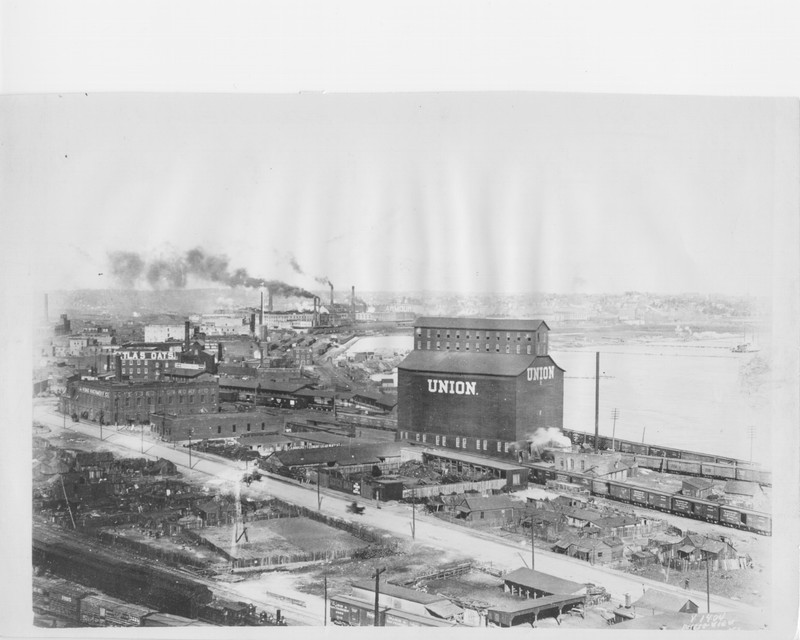West Bottoms: Hell's Half Acre
Introduction
Text-to-speech Audio
People referred to Kansas City's West Bottoms neighborhood as "Hell's Half Acre" around the turn of the twentieth century because of its crime, bars, brothels, and otherwise bad reputation. The community started as Kansas City's first African American enclave and later home to European immigrants. Both groups mainly worked as low-paid laborers. Many took part in constructing the Hannibal Bridge, the first railroad bridge across the Missouri River. The bridge opened on July 3, 1869, and became a critical component of the city's growth, especially its meatpacking industry. However, the neighborhood transformed into a place for outlaws, prostitutes, and gangs, eventually pushing out the African Americans and immigrants by the early twentieth century.
Images
Hannibal Bridge and Workers

Advertisement seeking to bring Black people to Kansas City

Photograph of "Hell’s Half Acre," including the Union Elevator Company

Backstory and Context
Text-to-speech Audio
The Hannibal Bridge, which connected Kansas City and its environs to the quickly-growing Chicago and eastern U.S. cities, served as the first permanent bridge across the Missouri River. Although the completion of the celebrated Transcontinental Railroad occurred two months before the Hanibal Bridge opened, the permanent bridge connecting Iowa to Nebraska through Omaha (on the Transcontinental route) did not open until 1873. Thus, for several years, Kansas City arguably offered a more desirable path, and African Americans played an integral role in making that happen.
In the wake of the Civil War, African Americans migrated northward, and many of them arrived in Kansas City in 1867 as the bridge project made employment a strong possibility. In addition to the bridge, West Bottoms supported the Union Depot, meatpacking plants, and several warehouses. The bulk of those working in West Bottoms received low wages and lived in shanties and shacks adjacent to the bridge project in the "West Bottoms" area of Kansas City. The young, struggling city enjoyed minimal development at the time, and the West Bottoms neighborhood offered almost nothing to its residents, including proper running water or sewage. But the cheap housing and access to employment eventually lured immigrants such as Germans, Irish, and Italians to West Town to work alongside African Americans; Whites eventually outnumbered Blacks in West Bottoms two to one by the first decade of the 1900s.
In the decades after the bridge opened, the low-income town eventually drew outlaws, prostitutes, gamblers, and other so-called "ne'er-do-wells." Brothels and bars lined the streets, giving it the name "Hell's Half Acre." As well, the lack of public works and proper sanitation led to disease, which readily spread among people living in close proximity to each other. African Americans and immigrants routinely left the neighborhood once they could afford better lodging, leading to a high transitory rate.
As the Gilded Age evolved into the Progressive Era, roughly between the 1880s and 1920s, grassroots organizations established hundreds of social-welfare organizations in poor urban neighborhoods. Settlement Houses and schools provided services, mainly to European immigrants, such as healthcare; English lessons and basic education; childcare; and employment resources. In West Bottoms, a group founded the Bethlehem Night School, which functioned as a sanctuary for mothers and children residing in Hell's Half Acre, where they could receive clothing and education.
By the early 1900s, few southern migrants remained in the neighborhood, and only a minority of immigrant families called West Bottoms home. Hell's Half Acre mainly supported poor, Missouri- or Kansas-born residents and transients. West Bottoms continued to transform after a devastating flood in 1903 killed nineteen people and destroyed 23,000 homes, leading to the city condemning homes and rebuilding the area; the neighborhood also dealt with substantial flooding in 1951 and 1993.
Sources
Flinn, Kara Evans. "Devastation and Convtroversry: A History of Floods in West Bottoms." The Kansas City Public Library. kchistory.org. August 11, 2014 https://kchistory.org/blog/devastation-and-controversy-history-floods-west-bottoms.
Jackson, David W. "Building Chanute's Bridge." Jackson County Historical Society. jchs.org. October 18, 2021. https://www.jchs.org/jchs-e-journal/2021/10/15/building-chanutes-bridge.
Scanlon, Heather and Bruce Holloway. "Hell's Half Acre: West Bottoms." African American Heritage Trail of Kansas City. aahtkc.org. Accessed May 10, 2022. https://aahtkc.org/hellshalfacre
Scanlon, Heather. "Tour Through Hell's Half-Acre." Squeezebox. squeezeboxcity.com. June 25, 2015. http://www.squeezeboxcity.com/tour-though-hells-half-acre/
Schirmer, Sherry Lamb. A City Divided: The Racial Landscape of Kansas City, 1900-1960. Columbia: University of Missouri Press, 2002.
Image courtesy of Miller Nichols Library, UMKC University Libraries. http://www.squeezeboxcity.com/tour-though-hells-half-acre/
http://www.squeezeboxcity.com/tour-though-hells-half-acre/
https://pendergastkc.org/collection/9130/10008066/hell%E2%80%99s-half-acre-west-bottoms
